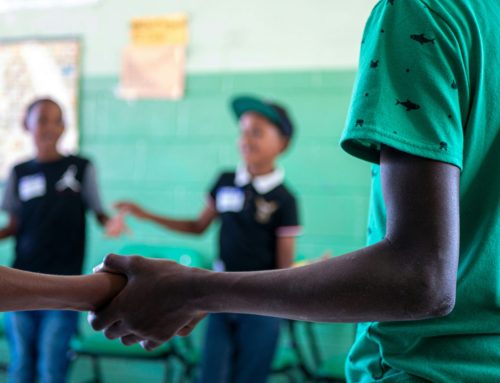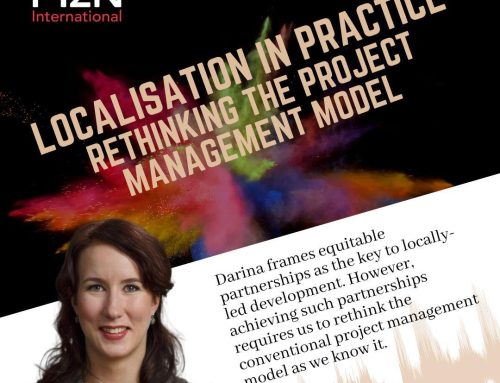Interviewed by Christian Meyer zu Natrup.
As the year is coming to an end, we reconnected with USAID to discuss with Matthew Johnson, Communications Director at the Office of Acquisition and Assistance USAID what lies ahead in 2024 for the world’s largest aid agency.

In short, Johnson highlights USAID’s strategic emphasis in 2024 on three key areas: Acquisition and Assistance, localization, and private sector engagement. He also provides insights into the optimal ways for local organizations to engage with USAID.
This conversation has been edited for length and clarity.
“I think the language that we use and the language private sector companies use is totally different.”
— Matthew Johnson, USAID
“Considering the various procurement holdups, staffing challenges and changes USAID faced in 2023, what can we anticipate in the year 2024?”
Focusing on Co-Creation – “On the procurement side, for many years we have been talking about doing more of what we call ‘co-creation’. For example, this would include requests for information, source of soft notices, issuing draft scopes of work – doing those sorts of things. When we first started tracking it five years ago, 6% of all new awards included some level of co-creation. This past year we were somewhere over 30% of all new awards and so, significant money, time and energy are going in that direction. By doing this, it puts all the information about our programs and activities out there for organizations, to know, understand and comment on, and even follow up with us on and let us know who they are.”
Staffing – “Staffing is still a major issue for us within our offices. When you get down to the actual basics of what it looks like to institute localization in the agency – simply, we don’t have enough people. The steps to overcome this are to hire more contracting officers, as well as empowering our local staff to do work.”
“With the current administration, the Acquisition and Assistance budget has increased, leading to a rise in procurement. Do you anticipate this trend to continue in 2024?”
“When you look at the acquisition system on a bigger picture, there are contracts, grants, and cooperative agreements. The significant increase in funding, particularly through Public International Organization grants, is evident when looking at the overall numbers, directly tied to Ukraine, COVID-19 response, etc.
But when you look at our actual programs of new awards activities everywhere else in the country, it remains relatively stable, the same as what it has been. And I do think long-term development programs have generally remained relatively stable. It’s been quite different from the humanitarian assistance side, where you see these massive fluctuations in funding over the last couple of years.”
“USAID is leading the charge in localization, the agency is investing into actively lowering the hurdles for local organizations you work with. What is the focus in localization efforts for 2024?”
“When we look at localization, we have a lot of the tools and resources. We need to work directly with partners, however, we don’t necessarily have the staffing or the institutional knowledge to do it – we are working to create the internal knowledge and staffing to localise more.
Then there’s the bigger picture of broader US government policy issues, like regulations and rules that restrict us from doing work. We are trying to find a way through regulations to localise more procurement decisions. One of the things we’re looking at is trying to be able to accept solicitations or applications in languages other than English.”
“How can local organizations engage with USAID to provide information, co-create programs and become a partner for assistance?”
“A big part of work with usaid.gov and our partner directory is trying to identify what organizations are out there and who can do the work. RFI (Request for Information) is another way of doing that or even issuing a draft scope of work. Oftentimes we’re issuing it, seeing who responds to it, and seeing what local organizations can do work.
We have to remember when you get to an RFI, there’s already been the country development cooperation strategy (CDC) that’s been developed. The agency’s policy offices work on incorporating local feedback input into that program and activity. Providing input there is a key part of it, asking what is actually driving our local priorities, and what are the types of programs and activities. In theory, by the time we get to the point of issuing an RFI or program activity, a priority activity has already been identified by the host government and local communities.”
The RFI Stage: “When we get to that RFI stage we’re looking at identifying:
- Who are the local organizations?
- Who has the capacity to do this work?
- What is our procurement strategy going to be? Is it going to be a US small business? Is it going to be a contract? Is it going to be a grant? Is it going to be a Cooperative agreement?
Responding back to these RFIs signals to our own workforce and staff that there are local organizations that can do this or no local organizations responding at all. Responding back to those RFIs is critical for local entities in helping to determine the procurement strategy. As we’re designing the program activity, we have different steps and phases where we can get input and feedback from local communities.
We’re always looking for what else we are missing: are there specific targeted regions or specific indicators for other specific areas or objectives of a program that we should be focused on? I think the RFIs provide an opportunity to get that information back into the agency as well.”
“By the time we get to the point of issuing an RFI or program activity, a priority activity has already been identified by the host government and local communities”
— Matthew Johnson, USAID
“What is going to be the focus in private sector engagement for 2024?”
Building a corporate portal – “We’ve been working with the private sector engagement team to build a corporate portal on workwithusaid.gov which we’re hoping to launch early next year.”
Engaging with the private sector to boost local economies – “Most private sector companies aren’t necessarily coming to USAID for funding, what they’re coming for is networks in countries. There’s this continued focus on how we are engaging with the private sector to boost local economies and to work in communities. The big focus right now is on how do we create an institutional structure within the agency to be able to support that kind of overarching goal and objective.
Creating this corporate portal will be kind of a front door for corporations to come to USAID. We have assigned relationship managers for a lot of the big organizations and each mission has a private sector engagement liaison. For example, if Coca-Cola wants to get work in Kenya, we’ve got somebody in Kenya who can work on it. But there’s also somebody back in DC who would be managing that relationship with Coca-Cola. A big part of building the institutional structure is to be able to support more long-term work with the private sector.”
Bridging the Gap between the development side and the corporate side is accelerating – “I think the language that we use and the language of private sector companies use is totally different. In designing our corporate portal we’re looking at every word and very intentionally selecting how we are calling our own staff, programs and activities. Making sure we are communicating in a way that connects with private sector companies and allows the agency to at least get them in the door and then have those conversations. I think oftentimes private sector organizations come to USAID and they don’t even know where to begin. They just kind of give up because this is a massive government bureaucracy. Which is why creating more simplified streamlined entry points into the agency and even training our own staff on how to better engage with the private sector is a big part of the work overall.”
“Are there any thematic innovations that USAID is looking at for 2024?”
“I still think localization is the Hot Topic. There’s a localization humanitarian systems strategy that’s coming out in the near future looking at how do we actually do localization within the humanitarian context. One of the challenges that USAID has is that everything is a priority. We really localize everything we do.”
“Is there anything near to your heart from an acquisition & assistance point of view that you would like to communicate?”
“There’s a couple of exciting things:”
Languages – “We’re trying to lead on languages and translations. We’re trying to translate the entire platform usaid.gov into French, Spanish and Arabic. We’re trying to create a fully functioning version of the website in those languages to make the agency more accessible.”
First and Last mile translation – “We just launched a pilot program, where in theory if our mission wants to see applications submitted in Spanish, we’ve actually set up a translation contractor. Applications can come in a different language and we can translate them.
On the flip side, we can also work with some of our standard contract documents and get those translated to get it back out to organizations, really trying to open up the ability for particularly local organizations that English is not their primary language to be able to do business with the agency.”
“Other than reading the CDC or responding to RFIs, what are the best ways to locally engage with USAID?”
“Beyond responding to RFIs, here are some steps I recommend:
- Read my blog outlining seven ways to connect with the agency and how to introduce yourself to the agency – read the article here.
- Our local offices regularly have industry days and local partner meetings. For example in Cambodia, they’re doing a local partner meeting and bringing together all the local organizations they have.
- Registering with usaid.gov- Follow the step-by-step guide.
- Point to our Sub-opportunities portal: there are thousands of organizations that are currently getting funding from USAID and there are thousands of other opportunities to work with USAID funding or with a large implementing partner” – see the Sub-Opportunities Portal.
Those are great entry points into the agency that will also help to understand some of the rules, requirements and overall approach in the way that USAID does business.”
We express our sincere appreciation to Matthew Johnson, Communications Director at the Office of Acquisition and Assistance, USAID, for sharing his time and invaluable insights into USAID’s strategies for 2024.




